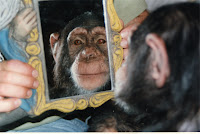By: Edwin Francisco Herrera Paz
I have no fear of an invasion of aggressive and
technologically advanced aliens, and you should not have it too. You may fear a
spider, a venomous snake, an earthquake or even your mother in law, but aliens....
For what do you think would happen if suddenly, either visibly or
surreptitiously, a horde of aliens visited us? It is a very good exercise to speculate.
Much has been written about a possible contact with
travelers from other worlds and its consequences. It has been said that these pos
technological beings, able to transport across millions of light years of
space, would possess such a state of advancement that, for them, humans would
be simple worms whose extermination would not have major consequences.
Of course, we extrapolate our conduct to beings with
thousands or perhaps hundreds of thousands of years of progress in relation to
us. We ascribe to them the emotions and passions typical to humans who are just
beginning to be aware of their own potential; who drag the heavy burden of their
genetic background imposed by their evolutionary history. But the fact is that
a race with technological advances just a few thousand years beyond would have
a very different behavior.

We humans enjoy the privilege of possessing a
consciousness that elevates us above the other animals of our world. However,
if we look carefully, our behavior conforms largely to a set of rules dictated
by evolution under ever-changing environmental pressures. We have the same
basic drives that motivate most living beings: we seek for food, flee from
danger or react aggressively to those who attack us; execute intricate rituals
in order to reproduce and perpetuate our genes; we share with other living
things feelings such as love, jealousy, anger and hate.
Even some behaviors that are considered specific to
our species have lost the privilege to correspond exclusively to mankind,
zenith of creation. We share much of our social transactions with chimpanzees
and bonobos, and it has been shown that more distantly related species,
evolutionarily speaking, are capable of incorporating social elements in their
groups once considered exclusively humans.1, 2

In this regard, Steven D. Levitt and Stephen J.
Dubner, in their bestseller “Superfreakonomics” (second part of their seminal,
iconoclastic “Freakonomics”) cite experiments in a community of Capuchin
monkeys in which the researchers introduced a type of currency as a form of
exchange. After a few months of training by conditioning the monkeys learned to
properly use the money in order to buy food. Surprisingly, economic
transactions identical to humans were seen, including those with a high dose of
irrationality. Negative behaviors also emerged, such as vandalism and prostitution,
so Levitt and Dubner titled this chapter of their book: "Monkeys are human too"
.3
Love, the most sublime of the sentiments, is extremely
common all across the animal kingdom. And this is not limited to creatures of
the same species. Altruistic and fraternal behaviors across species are
common. And that behavior is not unique to mammals. The fact is that altruism
with other species has been observed in a wide variety of animals. As an
example I will cite the case of a reptile. One day in October 2006 at the zoo
in Tokyo, the caregiver introduced into the cage of a rat snake, intended to be
a meal, a small hamster. The surprise for the caregivers was that far from eating
the rodent, the snake adopted him as his best friend. Since then, both share the
same cage.
There are hundreds of examples of altruism among species.
Definitely, our links with the animal kingdom are evident. We are tied to bestial
behavior, raised from our kinship with other species, and a clear example of
this, is that we must kill other living things for food.
Vestiges of
Evolution
As for the features that make a living thing - structural,
functional or behavioral - including ourselves, it can be observed in many
instances inaccuracies in design. And this is because evolution, at all levels,
uses existing structures to build new ones that suit the requirements of
individuals in a population at a certain time in a changing environment. Some
of these are "fit" to fulfill new functions, while others that could
not find a new "niche", remain part of the body without any function.
There are structures molded by a process of evolution whose
function is efficient, but obviously does not correspond to an intelligent
design. As an example, let's remember the human eye. In humans and mammals,
the eye is a camera with a set of light-sensitive cells. If the eye had been
designed by an engineer (assuming that engineer counts on the necessary technological
elements) would have never thought of it as it is.
In the organ of vision, the photosensitive layer (which
detects light) is behind the nerve cells leading visual sensations to the
brain. In a camera, that would be the equivalent of cables and circuits placed
in front of the photosensitive surface, interrupting arrival of light. This is
because the eye had to transform, from a simple photosensitive layer placed in
front of the nerve fibers in simple animals, to the one observed in higher
organisms that consists of a wide, transparent chamber. In the evolutionary process,
the photosensitive layer didn`t change its position.4

Let’s take a look at other example. The so called
"vestigial organs" have no function, but were useful in some moment
of the evolutionary history of a species. We humans have the vermiform
appendix, a small addition of the colon or large bowel, whose role is limited to
helping surgeons in paying the mortgages of their houses (when one gets
appendicitis). But in our arboreal herbivorous ancestors it may well have been
part of a longer large intestine, necessary for a diet rich in fiber, or
alternatively, it may have been an important part of the immune system.5
Similarly, humans exhibit some behaviors remnants of
our ancestors that have adapted to different needs over the millennia, and also
others that are no longer as useful, and maybe even unwanted. Thus, as pointed
above, many of our social and micro transactions, in addition to the basic
impulses like love and aggression, are share with our arboreal cousins.
Vestigial
Eugenics and Aggressive Behavior
Aggression, like his twin brother fear, is the product
of complex reactions in the brain structures of an animal (or a human) that
lead to the secretion of substances, especially adrenaline, which prepare for
fight or flight. Aggressive behavior has been historically favorable for humans
in certain situations - and still is to a certain extent - as it prepares our
bodies for hunting or for coping with rival tribes.6 However, in a more
civilized world, well regulated by laws, aggressive behavior will become
increasingly unnecessary and even counterproductive. We could say that, in this sense, vestigial.

The term eugenics was coined in 1865 for the first
time by Sir Francis Galton, cousin of Charles Darwin and founder of the
Biometric School. In short, eugenics became a social philosophy intended to
improve the human species by selection, genetic manipulation or any other form
of intervención.7 Initially popular among the scientific guild, was soon
adopted by many countries as a policy of state, but its reputation began to
decline when it was taken to the extreme by German Nazi party.8 Today, the term
is a sad reminder of how terribly disastrous a technology or idea could be when
applied incorrectly by politicians.
Various cultures have practiced the removal of
defective genetic variants through eugenics. In Ancient Sparta, children with
malformations or defects (and therefore with little potential for war) were
left to their own to be devoured by wild animals. The Nazis committed massive
genocide of Jews, as well as disabled people, and the United States conducted
contraception campaigns in nulliparous, young indigenous women in many parts of
the Americas. However, despite its current negative connotation, in certain
well-defined conditions genome alteration through genetic engineering methods
would be benign, because unlike previous approaches, it would respect human
life, and the abomination that the elimination of defective offspring
represents would no longer take place. The repairing of adverse genetic variants will
be possible. For many futurists, this fact will give us humans the ability to
guide our own evolution towards transhumanism.9
Humanity is currently in a cyclical phase of existence
as a species. The genomic analysis technologies, systems biology and DNA sequence
editing will soon allow correction of defective or undesirable physical or
psychological traits. Excessive aggressive behavior could, in extreme cases, be
controlled by these technologies.
But of course, every technology has its dark side. The
altered DNA sequences via genetic or genomic therapies could be applied by
governments to people in order to regulate conduct that would be disruptive or
inconvenient for those governments. The potential threat of turning citizens
into sheep, followers of the will of those in power is always a danger.
However, I must insist, eugenics itself could have a practical application in
the treatment of individuals with a markedly aggressive behavior.
 |
| We need eugenics |
Take the case of a convict charged with any offense
arising directly from his aggressive behavior, which also is found that his aggressiveness is mainly due to genetic factors. It would be
desirable for the inmate to remove the excessive aggressive genetic variants,
both within himself and from his offspring. Then, these variants could be
removed off his brain cells and his sperm by a DNA editing process, facilitating
the reintegration into society and improving his future generations.
This procedure would eliminate from the human genetic
pool, in each generation, a small proportion of the genetic variants that
contribute to extreme aggressive behavior until, a number of generations into
the future, aggressive variants were observed in a small proportion. Thus,
alleles of aggression would be phased, almost imperceptibly. In addition and in
parallel, the progressive development of society could lead to social stability
where aggression had no place. And with the reduction of aggressive behavior,
post-technological society would empty its prisons, but also acquire a greater
appreciation for life in all its forms.
Environmental
and genetic interactions
Someone scolded me one day that not only genes have an
influence in aggressive behavior, but also the rearing environment, education
and culture. Moreover, genetic manipulation poses a major ethical dilemma.
I must say that I am aware of the implied ethical
issues. However, proper regulation of the practices (what is allowed and what
is not) through legislation would obviate these difficulties. I personally think
that DNA sequence editing technologies will increasingly find niches in
biomedical branches, a trend that will be unstoppable. So instead of talking
prematurely about prohibitions, we must focus on the correct regulation.
Moreover, I have to accept that different aspects of
human behavior are multifactorial, i.e. in its various manifestations come into
play a number of socio-cultural, educational, environmental, and genetic
factors. I don’t mean to minimize the impact of education and family
environment in the genesis of aggression in an individual, but genetic influences
might be an important part of the behavior. Many behavioral (and even physical)
traits must have coevolved together with the sociocultural environment.10,11 Genetic
variants evolve, in some cases, to suit the sociocultural background, or is the
latter that is molded by the influence of genetic variants present in a
population, in a rather complex interaction.

For example, it has been proved that many physical
characteristics in humans appeared in the past 10,000 years in response to environmental
changes.12 Clear examples are simplification of the teeth by the introduction
of cooking in the diet, and genetic differences between populations in the
number of copies of the amylase gene. For the latter - an enzyme found in
saliva, useful in the digestion of carbohydrates –an increased activity due to
an increased number of copies of the gene in people with a traditional starch rich
diet has been demonstrated.13 Another notable example is the pigmentation of
the skin that is a function of latitude of residence: people who live at high
latitudes, where UVB ultraviolet rays necessary for the synthesis of dihydroxycholecalciferol
(vitamin D) are scarce, have developed a clear pigmentation, while in latitudes
close to the equator, dark pigmentation of the skin protects from cellular
damage produced by UVA radiation, which causes the destruction of folic acid.14
Although aggression is influenced by an interaction
between social, psychological development and the genetic background, we cannot
ignore the influence of genetic factors favored by evolution. To date, studies
have shown genetic influence on aggressive behavior. For instance, in 2010 Dr.
David Goldman and colleagues found, in Finnish men convicted of crimes related
to aggressiveness, a genetic variant in a brain receptor called HTR2B.15
Surprisingly, the variant was not found in other populations, and it apparently
also predisposes to alcoholism, drug addiction and suicidal behavior.
This research confirms that a factor to consider in
the study of aggressive behavior is sex. Male sex hormones (testosterone and
dihydrotestosterone), and the female (estrogen and progesterone), bind to receptor
molecules into target cells causing the on and off of a variety of genes that
cause changes leading to sexual differentiation in the embryo. But not less
important are its effects on the brain.
Sex hormones produced in the brain trigger a gene
cascade leading to the activation of specific neural networks. The result is
reflected in the behavioral characteristics of each sex, as part of so-called
sexual dimorphism. Some of these genes are involved in territorial aggressiveness
typical of male behavior, which has been tested in animal models.16
Belligerent behavior, driven by genetic variants such
as these could have evolved in our recent past. Formerly (and even now),
aggressive tribes used to attack other villages, eliminated or enslaved men,
and abducted women, giving them a greater opportunity to convey and disperse
their belligerence genes.17 However, in the future, eliminating aggressive
genetic variants will not only be desirable but absolutely necessary for the
survival of the human race in the long run, because I put in doubt that a
civilization with the technological capacity of self-annihilation can survive,
even for a few centuries, with the high levels of aggressiveness we observe in
modern humans.
Every day we see how we continue to drag on the
genetic variants of aggressiveness as they are the byproduct of our struggle to
survive. They are part of our biological nature. If a mosquito bites us, we
instinctively crush it without mercy in a sudden attack of aggression influenced
by our genes, since its sting of death makes us susceptible of being victims of
a potentially mortal disease. We do not stop to think that the mosquito is a
sophisticated biological machine shaped by millions of years. Our unconscious
assumes automatically that the bug lacks any degree of consciousness and love
to life, and hence, it does not deserve of our forgiveness. In an automated
movement we convert the mosquito into an insect soufflé. And our total ignorance
of the pain inflicted on a living organism, with a complete lack of empathy, is
not limited to mosquitoes. It also applies for cockroaches, flies, mice and
other living organisms.
Homini Homo Lupus
 The human being is a body of contrasts. We are extraordinarily
altruistic in some circumstances, but in others, extremely destructive. Our component
of intrinsic disdain for life of other beings is not limited to other species. It
was not until recently that Western societies decided, with fanfare, to proclaim
the equality of all men (and women, of course) before the law. Yet we see how
historically, xenophobia and belligerent behavior have led to aggression,
domination and enslavement of groups of peoples over others. I will mention some
outstanding cases. The North American Indians were hunted to virtual
extermination; Latin America's indigenous population was depleted; the black
Africans were exported as slaves in a profitable industry, conducted by what
was the first transnational corporation in the Americas: the Atlantic Slave
Trade; the Nazis built their extermination camps to kill Jews, and the Jews in
turn, have used the sacred texts of the Torah to justify the subjugation of the
Palestinians; Christians of the Middle Ages, used Scripture to launch their
crusades against Islamic world; in turn, Islamists now use their sacred texts (Koran)
to execute Christians accusing them of apostasy and to proclaim their
"holy war" or jihad; some states in the U.S., consider immigration a
crime, if the immigrant is a poor person from an undeveloped country; and
ethnic confrontations often reach the category of genocide in various parts of
Africa.
The human being is a body of contrasts. We are extraordinarily
altruistic in some circumstances, but in others, extremely destructive. Our component
of intrinsic disdain for life of other beings is not limited to other species. It
was not until recently that Western societies decided, with fanfare, to proclaim
the equality of all men (and women, of course) before the law. Yet we see how
historically, xenophobia and belligerent behavior have led to aggression,
domination and enslavement of groups of peoples over others. I will mention some
outstanding cases. The North American Indians were hunted to virtual
extermination; Latin America's indigenous population was depleted; the black
Africans were exported as slaves in a profitable industry, conducted by what
was the first transnational corporation in the Americas: the Atlantic Slave
Trade; the Nazis built their extermination camps to kill Jews, and the Jews in
turn, have used the sacred texts of the Torah to justify the subjugation of the
Palestinians; Christians of the Middle Ages, used Scripture to launch their
crusades against Islamic world; in turn, Islamists now use their sacred texts (Koran)
to execute Christians accusing them of apostasy and to proclaim their
"holy war" or jihad; some states in the U.S., consider immigration a
crime, if the immigrant is a poor person from an undeveloped country; and
ethnic confrontations often reach the category of genocide in various parts of
Africa.
We see the domain of man by man everywhere, or as it
was rightly stated by Titus Plautus Macio, popularized by Thomas Hobbes, homini homo lupus, i.e., man is wolf to
man. All these examples show that the equality of men is just an expression, a rhetoric
ideal put on a lifeless piece of paper. But although the domain of man by man
undoubtedly has deep cultural nuances, genes largely dictate surreptitiously
much of the local and global patterns of human aggressive behavior.
What about the
aliens?
And this is precisely the main reason why we believe
that aliens would have no mercy on us! We think that given their high level of
technology, we would likely be mosquitoes that they can destroy without further
scruples and no remorse. However for a post-technological society capable of
traveling to distant places, the danger of self-annihilation would have passed
long time ago. Irrational aggressiveness would have been left behind. The high
social order would make unnecessary the use of violence arising from the
emotions, and they would have known how to control their own genetic programming
long, long time ago.
An advanced race that visited us would have learned to
appreciate the true sense of the complexity of life, and far from exterminating
us, might help us in the process of evolution. Their high advanced technology would
allow them to observe us from a distance.
So, occasionally, I am afraid of the bad decisions made
by the president of my country; afraid to walk the streets of my city, one of the
most dangerous in the world; afraid of falling off the bed at night, during
sleep; afraid of an Islamic terrorist with a cargo of explosives attached to
his waist; or afraid of my sisters in law when they get angry. But aliens? Naaaaa!
No sir. I do not fear aliens; not at all.
Literature
cited
1. Roma PG, Silberberg A, Ruggiero AM, Suomi SJ.
Capuchin Monkeys, Inequity Aversion, and the Frustration Effect. Journal of
Comparative Psychology 2006, 120(1), 67–7.
2. Lakshminaryanan V, Keith Chen MK, Santos LR. Endowment
effect in capuchin monkeys. PhilosTrans R Soc Lond B Biol Sci. 2008, 363(1511):
3837–3844.
3. Levitt S y Dubner S. Superfreakonomics. William
Morrow, 2009.
4. Lamb TD. Evolution of the Eye. Scientific American.
Julio 1, 2011.
5. Randal Bollinger R, Barbas AS, Bush EL, Lin SS,
Parker W. Biofilms in the large bowel suggest an apparent function of the human
vermiform appendix. J Theor Biol. 2007, 249(4): 826-31.
6. Parker GA. Assessment strategy and the evolution of
fighting behaviour. Journal of Theoretical Biology. 1974, 47(1): 223-243.
7. Larson EJ. Sex, Race and Science: Eugenics in the
Deep South. The John Hopkins University Press, Baltimore, 1995.
8. Kühl S. The Nazi connection: eugenics, American
racism, and German national socialism. Oxford University Press, Nueva York,
1994.
9. Huxley J. Transhumanism. Journal of Humanistic
Psychology. 1968, 8(1): 73-76.
10. Rushton JP, Littlefield CH, Lumnsden CJ.
Gene-culture coevolution of complex social behavior: Human altruism and mate
choice. Proc. Natl. Acad. Sci. USA. 1986, 83: 7340-7343.
11. Samuel Bowles S, Choic JK, Hopfensitz A. The
co-evolution of individual behaviors and social institutions. Journal of
Theoretical Biology. 2003, 223: 135–147.
12. Cochran G, Harpending H. The 10,000 Year
Explosion: How Civilization Accelerated Human Evolution. Perseus Book Group.
2009.
13. Perry GH, Dominy NJ, Claw KG y Col. Diet and the
evolution of human amylase gene copy number variation. Nat Genet. 2007, 39(10):
1256–1260.
14. Jablonski NG, Chaplin G. Human skin pigmentation
as an adaptation to UV radiation. Proc Natl Acad Sci U S A. 2010,
107(Supplement_2): 8962–8968.
15. Bevilacqua L, Doly S, Kaprio J, y Col. A
population-specific HTR2B stop codon predisposes to severe impulsivity. Nature.
2010, 468(7327): 1061.
16. Xu X, Coats JK, Yang CF, y Col. Modular Genetic
Control of Sexually Dimorphic Behaviors. Cell. 2012, 148(3): 596-607.
17. Lehmann L, Feldman MW. War and the evolution of
belligerence and bravery. Proc. R. Soc. B. 2008, 275(1653): 2877-2885.
 Porque, no me diga que a usted no le ha pasado esto.
Sucede todo el tiempo, en los momentos menos indicados. Usted se encuentra en
un coctel diplomático con un plato de canapés en una mano, la copa de vino en
la otra y platica nimiedades con el Primer Secretario de la Embajada de
Lituania mientras pone cara de que está reparando el planeta Tierra. De repente
siente la picazoncita. Primero mueve los hombros disimuladamente para ver si se
quita, pero nada. Más bien la comezón va en in
crescendo, como si se tratara del “Bolero” de Ravel.
Porque, no me diga que a usted no le ha pasado esto.
Sucede todo el tiempo, en los momentos menos indicados. Usted se encuentra en
un coctel diplomático con un plato de canapés en una mano, la copa de vino en
la otra y platica nimiedades con el Primer Secretario de la Embajada de
Lituania mientras pone cara de que está reparando el planeta Tierra. De repente
siente la picazoncita. Primero mueve los hombros disimuladamente para ver si se
quita, pero nada. Más bien la comezón va en in
crescendo, como si se tratara del “Bolero” de Ravel.  Pasados unos segundos, la sensación comienza a
hacerse más incómoda y en un intento de autocontrol, se le queda viendo
fijamente al diplomático y le comienzan a llorar los ojos. Ya no aguanta más,
pide permiso a su interlocutor, busca un lugar donde dejar el plato y la copa y
sale semi disparado pero disimulando hacia el baño, entra intempestivamente, y
a pesar de que la experiencia le ha enseñado una y otra vez que no se puede
alcanzar ese fugaz e inaccesible punto de la espalda, trata en vano por arriba
y luego por debajo, y al verse fracasado en el intento busca un poste, una
columna, una pared…. Cualquier cosa con tal de desahogarse. Por fin encuentra
el filo de una pared y procede a apoyar la espalda y a realizar movimientos
ascendentes y descendentes como si de un oso rascándose en un árbol se tratara,
y nota como la verdadera paz va retornando a su alma. ¡Cual glamour! ¡Cual
centro de la creación!
Pasados unos segundos, la sensación comienza a
hacerse más incómoda y en un intento de autocontrol, se le queda viendo
fijamente al diplomático y le comienzan a llorar los ojos. Ya no aguanta más,
pide permiso a su interlocutor, busca un lugar donde dejar el plato y la copa y
sale semi disparado pero disimulando hacia el baño, entra intempestivamente, y
a pesar de que la experiencia le ha enseñado una y otra vez que no se puede
alcanzar ese fugaz e inaccesible punto de la espalda, trata en vano por arriba
y luego por debajo, y al verse fracasado en el intento busca un poste, una
columna, una pared…. Cualquier cosa con tal de desahogarse. Por fin encuentra
el filo de una pared y procede a apoyar la espalda y a realizar movimientos
ascendentes y descendentes como si de un oso rascándose en un árbol se tratara,
y nota como la verdadera paz va retornando a su alma. ¡Cual glamour! ¡Cual
centro de la creación! Todos somos hijos de Dios, ¿No es cierto? Entonces la
lógica nos dicta que los árbitros de futbol también son hijos de Dios, aunque
en un partido sea más probable que a quien le saque a relucir usted sea a la
mamá. Pero asumamos que sí, que también son hijos de Dios los árbitros. ¿Se ha
fijado la manera en la que durante un encuentro los réferis de futbol son capaces
de cruzarse la cancha enterita corriendo de retroceso? ¡Increíble! Y lo hacen
sin voltear a ver, una práctica común en los cangrejos pero que en los humanos
resulta contraproducente. Contésteme entonces, ¿Por qué Dios, en su infinita
misericordia, no se acordó de los árbitros de futbol y les puso un ojo extra a
nivel del occipucio o de la nuca? No solamente podrían correr hacia atrás con
mayor soltura y agilidad, sino que también serían más certeros ahorrándose las
mentadas de madre de los aficionados.
Todos somos hijos de Dios, ¿No es cierto? Entonces la
lógica nos dicta que los árbitros de futbol también son hijos de Dios, aunque
en un partido sea más probable que a quien le saque a relucir usted sea a la
mamá. Pero asumamos que sí, que también son hijos de Dios los árbitros. ¿Se ha
fijado la manera en la que durante un encuentro los réferis de futbol son capaces
de cruzarse la cancha enterita corriendo de retroceso? ¡Increíble! Y lo hacen
sin voltear a ver, una práctica común en los cangrejos pero que en los humanos
resulta contraproducente. Contésteme entonces, ¿Por qué Dios, en su infinita
misericordia, no se acordó de los árbitros de futbol y les puso un ojo extra a
nivel del occipucio o de la nuca? No solamente podrían correr hacia atrás con
mayor soltura y agilidad, sino que también serían más certeros ahorrándose las
mentadas de madre de los aficionados. 



































